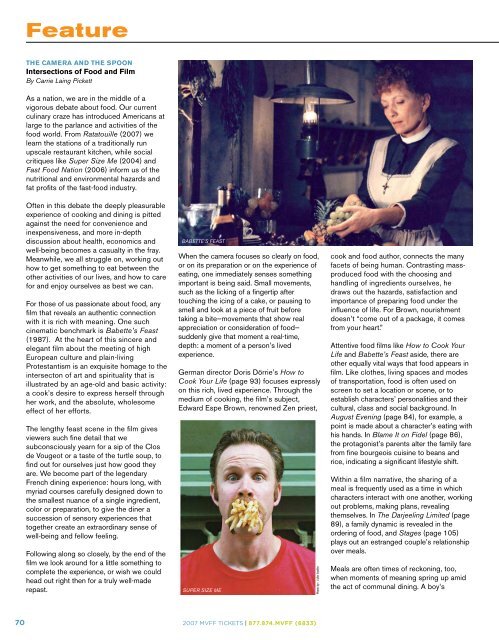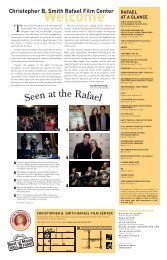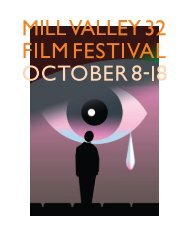ons stival . - California Film Institute
ons stival . - California Film Institute
ons stival . - California Film Institute
You also want an ePaper? Increase the reach of your titles
YUMPU automatically turns print PDFs into web optimized ePapers that Google loves.
Feature<br />
the CaMera and the spoon<br />
intersecti<strong>ons</strong> of Food and <strong>Film</strong><br />
By Carrie Laing Pickett<br />
As a nation, we are in the middle of a<br />
vigorous debate about food. Our current<br />
culinary craze has introduced Americans at<br />
large to the parlance and activities of the<br />
food world. From ratatouille (2007) we<br />
learn the stati<strong>ons</strong> of a traditionally run<br />
upscale restaurant kitchen, while social<br />
critiques like super size Me (2004) and<br />
Fast Food nation (2006) inform us of the<br />
nutritional and environmental hazards and<br />
fat profits of the fast-food industry.<br />
Often in this debate the deeply pleasurable<br />
experience of cooking and dining is pitted<br />
against the need for convenience and<br />
inexpensiveness, and more in-depth<br />
discussion about health, economics and<br />
well-being becomes a casualty in the fray.<br />
Meanwhile, we all struggle on, working out<br />
how to get something to eat between the<br />
other activities of our lives, and how to care<br />
for and enjoy ourselves as best we can.<br />
For those of us passionate about food, any<br />
film that reveals an authentic connection<br />
with it is rich with meaning. One such<br />
cinematic benchmark is Babette’s Feast<br />
(1987). At the heart of this sincere and<br />
elegant film about the meeting of high<br />
european culture and plain-living<br />
Protestantism is an exquisite homage to the<br />
intersecton of art and spirituality that is<br />
illustrated by an age-old and basic activity:<br />
a cook’s desire to express herself through<br />
her work, and the absolute, wholesome<br />
effect of her efforts.<br />
The lengthy feast scene in the film gives<br />
viewers such fine detail that we<br />
subc<strong>ons</strong>ciously yearn for a sip of the Clos<br />
de Vougeot or a taste of the turtle soup, to<br />
find out for ourselves just how good they<br />
are. We become part of the legendary<br />
French dining experience: hours long, with<br />
myriad courses carefully designed down to<br />
the smallest nuance of a single ingredient,<br />
color or preparation, to give the diner a<br />
succession of sensory experiences that<br />
together create an extraordinary sense of<br />
well-being and fellow feeling.<br />
Following along so closely, by the end of the<br />
film we look around for a little something to<br />
complete the experience, or wish we could<br />
head out right then for a truly well-made<br />
repast.<br />
BaBEttE’s FEast<br />
When the camera focuses so clearly on food,<br />
or on its preparation or on the experience of<br />
eating, one immediately senses something<br />
important is being said. Small movements,<br />
such as the licking of a fingertip after<br />
touching the icing of a cake, or pausing to<br />
smell and look at a piece of fruit before<br />
taking a bite—movements that show real<br />
appreciation or c<strong>ons</strong>ideration of food—<br />
suddenly give that moment a real-time,<br />
depth: a moment of a person’s lived<br />
experience.<br />
German director doris dörrie’s How to<br />
Cook Your Life (page 93) focuses expressly<br />
on this rich, lived experience. Through the<br />
medium of cooking, the film’s subject,<br />
edward espe brown, renowned Zen priest,<br />
suPEr siZE ME<br />
70 2007 MVFF TICKETS | 877.874.MVFF (6833)<br />
cook and food author, connects the many<br />
facets of being human. Contrasting massproduced<br />
food with the choosing and<br />
handling of ingredients ourselves, he<br />
draws out the hazards, satisfaction and<br />
importance of preparing food under the<br />
influence of life. For brown, nourishment<br />
doesn’t “come out of a package, it comes<br />
from your heart.”<br />
Attentive food films like How to Cook Your<br />
Life and Babette’s Feast aside, there are<br />
other equally vital ways that food appears in<br />
film. like clothes, living spaces and modes<br />
of transportation, food is often used on<br />
screen to set a location or scene, or to<br />
establish characters’ personalities and their<br />
cultural, class and social background. In<br />
august Evening (page 84), for example, a<br />
point is made about a character’s eating with<br />
his hands. In Blame it on Fidel (page 86),<br />
the protagonist’s parents alter the family fare<br />
from fine bourgeois cuisine to beans and<br />
rice, indicating a significant lifestyle shift.<br />
Within a film narrative, the sharing of a<br />
meal is frequently used as a time in which<br />
characters interact with one another, working<br />
out problems, making plans, revealing<br />
themselves. In the Darjeeling Limited (page<br />
89), a family dynamic is revealed in the<br />
ordering of food, and stages (page 105)<br />
plays out an estranged couple’s relati<strong>ons</strong>hip<br />
over meals.<br />
Meals are often times of reckoning, too,<br />
when moments of meaning spring up amid<br />
the act of communal dining. A boy’s




